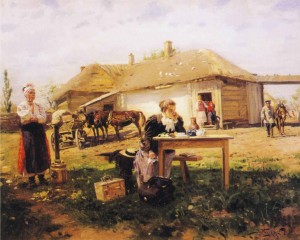Waldorf News
Report and Birthday Verses: Healing Forces in the Word and its Rhythms

Healing Forces in the Word and its Rhythms
Heinz Mueller
The report verses, as they are known in Europe, or the birthday verses, as they have come to be known in America, are individual verses that the teacher composes for the student each year. The child then speaks the verse, usually once a week in front of the class, for the coming school year. The verse speaks to a certain part of the child, whether a strength, a limitation or a challenge. Heinz Mueller developed the art of the report verse during his years of teaching in Hamburg. Using Rudolf Steiner’s indications, he pioneered the crafting of the verses which he shared in his book Healing Forces in the Word and its Rhythms. In the book he explores all aspects of the verse writing including the different meters for different temperaments and he gives many examples of the verses that he composed for his students. The examples often cover six to eight years of school life for a student. -David Kennedy, editor
“Far more than with our thinking, the word binds itself together with our feeling, and far more strongly again with everything that lies in the will. Feeling belongs to a much more unconscious part of the soul than thinking, and willing to a still less conscious part than feeling. For thinking, the words we speak amount to little more, as it were, than signs; to feeling it has a far more intimate connection. It joins forces with feeling far more closely, and especially closely does it do so with willing.”-Rudolf Steiner
For forty-two years, I was a teacher in the Rudolf Steiner School at Hamburg-Wandsbek, where I had been sent in 1923 by Rudolf Steiner himself. I am now using the leisure accorded me in my later years by destiny to recall and think over what I have done in the calling so dear to me. From my earliest childhood on, it was as though lines of guidance had sent their rays through my life and the themes of my life’s endeavor had already made themselves heard again and again. Indeed, I came to see that this “prelude,” as it were, was an integral part of the whole composition, and that later variations could be understood only if the earlier intimations of the basic themes were not passed over.
What Are Report Verses and How Are They Used in the Classroom?
When once the Waldorf School was founded in Stuttgart on September 22, 1919, the question came up as to how often and in what form reports were to be given. At first Rudolf Steiner thought they would have to be given twice a year, but it soon became obvious that neither the authorities nor the parents were expecting this. So it became the practice to give reports at the end of the school year.

On the report forms a large space is reserved for what the class teacher has to say about the pupil in question. Rudolf Steiner attached the greatest value to the making of as individual a picture of the child as possible. In doing this one was to avoid negative comments. The teacher was to go deeply into the character, the abilities but also the deficiencies and weaknesses of his pupils in as loving a way as he could and to present everything with unfailing goodwill.
Only after this should there then follow something of an assessment of what had been accomplished. The picture thus put forward must of course be really faithful and free of distortion. But here also there was to be no suggestion of sitting in judgment or condemnation; rather was there to be shown how an improvement was to be brought about. Whereas with the younger classes this part of the report was to be directed exclusively to the parents, in the middle school one was to address oneself also to the children themselves. Finally the class teacher was to sum up in a verse what he considered should accompany the pupil as inner guidance during the following year. In a college meeting on May 26, 1921, Rudolf Steiner indicated succinctly what he expected in reports. “We are agreed that we should write the reports as we did last year. As faithful a picture as possible; at the end once more a verse that can show the individual child the direction in which he should strive.” On various occasions he emphasized that it was good for the teacher to make the verse up himself.
What with the advertisements, traffic turmoil and the like which they meet with on their way to school, especially in the big towns, children arrive in a condition that needs healing as far as possible before one can reasonably begin any work. It is above all important that the noise and tumult of the streets should not be carried over into the lesson. The teacher best meets this by seeing that the children wait quietly to be greeted by him with a handshake before they enter the classroom. One must then stay with them till the bell rings for lessons to begin. During this time there may be notes for the parents to be given out or perhaps money to be collected; or things may need to be made ready for a painting lesson, one of which with water colors is usually held each week.
At the beginning of the lesson, teacher and children say a morning verse together. Then there comes some music, with younger children playing block flutes (recorders) in unison, and later on other instruments as well. As well as this there will be practice in choral singing with instrumental accompaniment. Finally a series of speech exercises are done by the children either singly or together, in which the utmost exactitude must be worked for.
After this it is time for the report verses to be said. If one has only a small number of children one can perhaps let them all say their verses each day. In the very big classes I myself had it was a matter of dividing up the children, which led to some interesting groupings. I so arranged it that every child said his verse on the day of the week on which he was born, with the Sunday children leading off on Monday mornings. To begin with, in the earlier weeks of the new school year I myself first said each verse in as good a speech as possible, but later on this was no longer necessary.
 It was often very astonishing to see how remarkable karmic correspondences showed themselves in the groups arising in this way out of the weekdays of birth. In one class for example there was a Wednesday group in which many of the children needed something special for their health, as if they had sought out the Mercury day for their entry onto the earth. Of children who had already been friends before they began to attend school would find themselves in the same verse group through their birth on the same weekday. It could be recommended to every class teacher to investigate such day connections. The experiences gained in this way are for the most part so delicate and intimate that one hesitates to put them into words.
It was often very astonishing to see how remarkable karmic correspondences showed themselves in the groups arising in this way out of the weekdays of birth. In one class for example there was a Wednesday group in which many of the children needed something special for their health, as if they had sought out the Mercury day for their entry onto the earth. Of children who had already been friends before they began to attend school would find themselves in the same verse group through their birth on the same weekday. It could be recommended to every class teacher to investigate such day connections. The experiences gained in this way are for the most part so delicate and intimate that one hesitates to put them into words.
After all these preliminaries the children are ready for the lesson itself, free now from any outside influences that could disturb or endanger the work. The most important thing of all is that, through an intimately artistic way of working, children are enabled to receive what the teaching offers quite differently from what they can when they are simply approached intellectually. It is one of the greatest joys of a class teacher, when visiting parents, to discover how just the report verses have come to such life in the children. They will often be heard talking among themselves about their verses, and that with a real pride in them. The teacher can then hope that the word has indeed made its way into the feeling and the will just as Rudolf Steiner expressed it: “Far more than with our thinking, the word binds itself together with our feeling, and far more strongly again with everything that lies in the will. Feeling belongs to a much more unconscious part of the soul than thinking, and willing to a still less conscious part than feeling. For thinking, the words we speak amount to little more, as it were, than signs; to feeling it has a far more intimate connection. It joins forces with feeling far more closely, and especially closely does it do so with willing.”
How responsible therefore is the work with the report verses, and how great is the healing we can achieve through them if we bestir ourselves over them with all our might!
Healing Forces in the Word and its Rhythms is available from Rudolf Steiner College Bookstore.
Roberto Trostli wrote an article in which he provides many examples of verses inspired by Heinz Mueller’s indications that he composed for his students while he taught at The Hartsbrook School in Hadley, MA from 1991-1999. Students were given their verses on their birthdays or half-birthdays for those who had summer birthdays. For the following year, the students recited their birthday verse in class on the day of the week on which they were born, with Saturday and Sunday birthdays distributed among the other days. Roberto now teaches at the Richmond Waldorf School. Read Roberto Trostli’s article about his experience with birthday verses here.
This article was written by Heinz Mueller and translated by Jesse Darrell, who taught for many years at Michael Hall School in London and Forest Row. It was originally published in English in 1986.
It is one of the many articles about Waldorf education in the latest Journal for Anthroposophy entitled Waldorf Education. The 2010 Journal brings together many articles about Waldorf education from past issues in the “Classics from the Journal for Anthroposophy” series. The Journal for Anthroposophy is available here.
Featured paintings:
An Old Man and His Grandson by Domenico Ghirlandaio
Teacher Visiting a Village by Vladimir Yegorovich Makovsky
Portrait of a Young Man by Sandro Botticelli
 Bay Area Teacher Training
Bay Area Teacher Training Training in Traumatology & Artistic Therapies
Training in Traumatology & Artistic Therapies Great books for Waldorf Teachers & Families
Great books for Waldorf Teachers & Families Summer Programs - Culminating Class Trips
Summer Programs - Culminating Class Trips ~ Ensoul Your World With Color ~
~ Ensoul Your World With Color ~ Transforming Voices Worldwide
Transforming Voices Worldwide Everything a Teacher Needs
Everything a Teacher Needs Preparing Teachers for 2024-25 Grades 1-8
Preparing Teachers for 2024-25 Grades 1-8 Immersive Academics and Arts
Immersive Academics and Arts Full-Time Teacher Education
Full-Time Teacher Education Middle School Science With Roberto Trostli
Middle School Science With Roberto Trostli Grade Level Training in Southern California
Grade Level Training in Southern California Association for a Healing Education
Association for a Healing Education Waldorf Training in Australia
Waldorf Training in Australia Jamie York Books, Resources, Workshops
Jamie York Books, Resources, Workshops Space speaks. Its language is movement.
Space speaks. Its language is movement. Waldorf Stories for Everyone
Waldorf Stories for Everyone Bringing Love to Learning for a Lifetime
Bringing Love to Learning for a Lifetime Waldorf-inspired Homeschool Curriculum
Waldorf-inspired Homeschool Curriculum Train to Teach in Seattle
Train to Teach in Seattle Flexible preparation for your new grade
Flexible preparation for your new grade Caring for All Stages of Life
Caring for All Stages of Life Quality Education in the Heartland
Quality Education in the Heartland Grade-specific web courses for teachers
Grade-specific web courses for teachers Roadmap to Literacy Books & Courses
Roadmap to Literacy Books & Courses The Journey is Everything
The Journey is Everything RSS Feeds
RSS Feeds